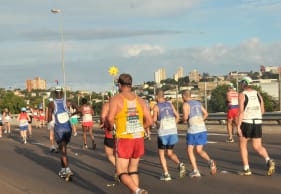ANSWER
There are so many variables that need to be taken into account here: What type of pain is it? Does the pain go away as soon as you stop, or does it stay for a period of time afterwards? Do you always run on the same camber of the road? Have you had any previous injuries involving your left side?
Just by telling me what type of pain it is will guide me in a much better direction. If it’s a sharp shooting or burning pain, sciatic nerve compression is most likely. In this case, the pain normally starts from your bum area down towards your calves and not vice versa as you described. For pain relief here, gluteal and hamstring stretching is the best thing to do.
If it’s a dull ache, it’s more likely a muscular problem, especially the piriformis muscle being too tight and too weak, and not providing enough stability to the pelvis, while a deep gnawing pain tells me it’s osteogenic, meaning bone-related. This could be due to a leg length discrepancy and cause pain due to overcompensation of the one side of the body.
Stinging pain suggests muscular imbalances, such as your calves, hamstrings and quadriceps not being strong enough and not providing your joints with enough stability during running. You mentioned the pain gets worse during hill running. This is a great indicator of the muscles being too weak. Strengthening of the posterior muscles is very important for runners, especially the calves and hamstrings. One thing you can try during a run is to walk up the hills; this will strengthen your calves, whereas trying to run it will work your quadriceps more and put more strain on your weaker calves.
My suggestion is to see a professional, especially because you’ve been struggling with the problem for two years now. A chiropractor would be able to assist with all areas discussed here. A biokineticist would do a full biomechanical analysis, to pinpoint the problem area and fix it once and for all. Remember, all problems are fixable, as long as you seek the professional help you need. Your body is your temple, treat it as such.
Modern Athlete Expert
ANDRIES LODDER
Biokineticist at the Technogym Wellness Centre in Fourways, Johannesburg, lecturer in exercise science and Ironman finisher. Andries specialises in sport and orthopaedic rehabilitation and sport-specific testing and conditioning. (www.topbio.co.za)
How do I Run Faster?
I have started training for Comrades 2012, but am running too slowly to complete a 21km race within the three-hour cut-off. How can I increase my speed from my current 9min/km to the acceptable minimum of 6min/km? – DAVID SELBY, JOHANNESBURG
ANSWER
First of all, well done for being on the road. No matter how slow you are, you have made a start. Now to get you running a little quicker.
At first you will need to take a short distance within your training run and go faster than your average speeds. For example, if you are doing an 8 or 10km training run, choose a flat, short section of say 2km and try to run at between 6 and 7min/km over this section. Do this at least twice in your first week. Over the next few weeks try to increase the length of your fast section to between 3 and 4km. As you get used to this faster running, keep the distance of the fast section the same, but try to run faster, say between 5:30 and 6min/km.
Slowly you will teach your body and your mind to run faster, and I believe that you will start to drop your overall speed in your training runs. Becoming fit enough to run the Comrades is a long, slow process, so take it one step at a time. Also, look in this edition for an article on my 40th Comrades Bus in 2012. Maybe you will be on it?
Modern Athlete Expert
BARRY HOLLAND
Running coach with 34 years’ experience, and has run 39 consecutive Comrades Marathons. His PBs include 1:17 (21.1km), 2:39:30 (42.2km) and 6:29:22 (Comrades).


